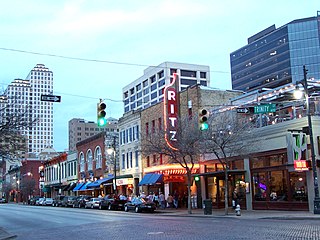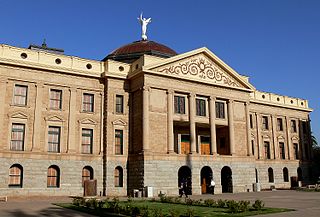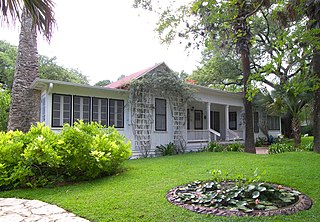
Georgetown is a city in Texas and the county seat of Williamson County, Texas, United States. The population was 67,176 at the 2020 census. It is 30 miles (48 km) north of Austin.

Sixth Street is a historic street and entertainment district in Austin, Texas, located within the city's urban core in downtown Austin. Sixth Street was formerly named Pecan Street under Austin's older naming convention, which had east–west streets named after trees and north–south streets named after Texas rivers.

Lyndon B. Johnson National Historical Park is a United States National Historical Park in central Texas about 50 miles (80 km) west of Austin in the Texas Hill Country. The park protects the birthplace, home, ranch, and grave of Lyndon B. Johnson, 36th president of the United States. During Johnson's administration, the LBJ Ranch was known as the Texas White House because the President spent approximately 20% of his time in office there.

Hyde Park is a neighborhood and historic district in Austin, Texas. Located in Central Austin, Hyde Park is defined by 38th Street to the south, 45th Street to the north, Duval Street to the east, and Guadalupe Street to the west. It is situated just north of the University of Texas and borders the neighborhoods of Hancock and North Loop.

The Texas Historical Commission is an agency dedicated to historic preservation within the U.S. state of Texas. It administers the National Register of Historic Places for sites in Texas.

The Old West Austin Historic District is a residential community in Austin, Texas, United States. It is composed of three neighborhoods located on a plateau just west of downtown Austin: Old Enfield, Pemberton Heights, and Bryker Woods. Developed between 1886 and 1953, the three historic neighborhoods stretch from Mopac Expressway east to Lamar Boulevard, and from 13th Street north to 35th Street. It borders Clarksville Historic District and the West Line Historic District to the south.

The H. P. Luckett House is a Queen Anne style house located in Bastrop, Texas. The 14-room house was built around 1892 for Dr. H.P. Luckett, a prominent citizen who had practiced medicine in the town for almost 50 years. The structure was listed in the National Register of Historic Places on December 22, 1978, and designated a Recorded Texas Historic Landmark in 2011.

James Riely Gordon was an architect who practiced in San Antonio until 1902 and then in New York City, where he gained national recognition. J. Riely Gordon is best known for his landmark county courthouses, in particular those in Texas. Working during the state's "Golden Age" (1883–1898) of courthouse construction, Gordon saw 18 of his designs erected from 1885 to 1901; today, 12 remain.

Magoffin Home is located in El Paso, Texas. It was placed on the National Register of Historic Places in 1971. The surrounding area was declared the Magoffin Historic District on February 19, 1985. The home is now known as the Magoffin Home State Historic Site under the authority of the Texas Historical Commission.

The Neill–Cochran House Museum is a historic home in north-central Austin, Texas. Master builder Abner Cook designed and built the house in 1855 as a suburban estate many years before the surrounding area was settled by other homes and businesses. The two-story Greek Revival home features prominent Doric columns and Mr. Cook's signature "sheaf of wheat" balusters.

The Clarksville Historic District in Austin, Texas, is an area located west of downtown Austin near Lady Bird Lake and just northeast of the intersection of the Missouri Pacific Railroad and West Tenth Street. Many historic homes and structures are located within the Clarksville Historic District. While Clarksville is geographically part of the Old West Austin Historic District, it is distinct from the two historic neighborhoods of Old Enfield, which lies immediately to the north on the eastern side of Texas State Highway Loop 1, and Tarrytown, which is situated to the west and northwest on the western side of Mopac.

The Southgate–Lewis House is located one mile east of the Texas State Capitol in Austin, Texas, at 1501 East 12th Street. The house was constructed in 1888, and now stands as an African-American historical landmark. It is also a repository for African-American History and Culture in the region of east Austin, which historically became an African-American neighborhood. The City of Austin has now declared this region to be "Austin's Black Cultural District." The Southgate–Lewis House is located in the center of the "African American Cultural Heritage District".

The Rainey Street Historic District is a street of historic homes, many of the bungalow style, in downtown Austin, Texas.

The Millett Opera House, home of the Austin Club, is a historic building in downtown Austin, Texas. Built in 1878 by local lumber seller Charles Millett on one of his lots, the house was one of the largest performance spaces in Texas upon its completion. It featured 800 removable seats, 24-inch limestone walls, and the largest enclosed space in Texas. The Opera House was designed by Frederick Ruffini, an architect working throughout Texas.

The Mayfield–Gutsch Estate, now named Mayfield Park, is a historic cottage, gardens and nature preserve in west Austin, Texas on a bluff overlooking Lake Austin. Originally built in the 1870s, the cottage was purchased by former Texas Secretary of State Allison Mayfield in 1909. In 1922, the house passed to Mayfield's daughter, Mary Frances, and her husband, University of Texas professor Milton Gutsch. They expanded the home, adding porches on three sides and, with the help of gardener Esteban Arredondo, greatly developed 2 acres (0.81 ha) of the property around their home into a botanical garden surrounded by a rock perimeter wall. When Mary Mayfield Gutsch died in 1971, the home and grounds were left to the City of Austin for use as a park. The property was listed on the National Register of Historic Places on September 29, 1994.

This is a list of the National Register of Historic Places listings in Travis County, Texas.

The Cox–Craddock House is a historic Colonial Revival-style house built in 1928 in Austin, Texas. It was designed by the architect Hugo Kuehne.

Fischer is an unincorporated community in Comal County, Texas, United States. The population was 688 at the 2010 census. The community is a part of the Texas-German Belt which runs from Schulenburg in the east, and west through the Hill Country to Fredericksburg. Most residents of Fischer have German-Texan ancestry, and the name Fischer is named after Otto and Hermann Fischer, German immigrants.

Buford Tower is a tower standing along the north shore of Lady Bird Lake in downtown Austin, Texas. The structure was originally built in 1930 as a drill tower for the Austin Fire Department, but it now serves as a bell tower and landmark. Named after fire department Captain James L. Buford, the structure has been listed on the National Register of Historic Places since 2016.

The Seaholm Power Plant is a historic former power station located on the north shore of Lady Bird Lake in Downtown Austin, Texas. Opened in 1951, it is listed on the National Register of Historic Places and designated as a Recorded Texas Historic Landmark. The power plant ceased operation in 1996, and the facility and site were later redeveloped into a mixed-use district.






















